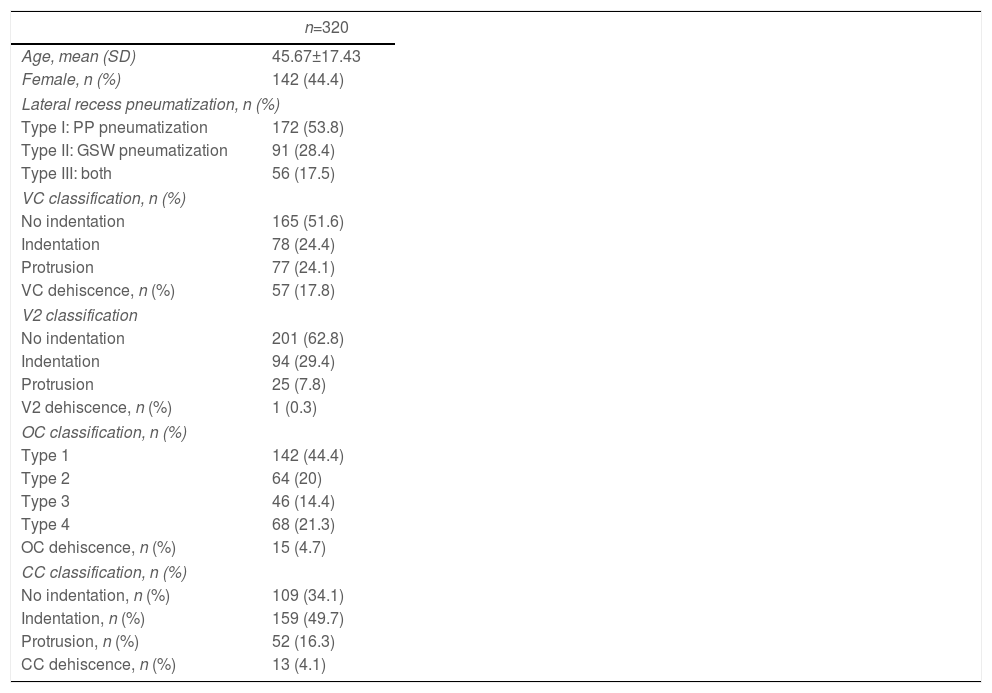Anatomical variations of the lateral recess of the sphenoid sinus and its relations with the adjacent neurovascular structures should be preoperatively evaluated to plan an adequate surgical approach and avoid iatrogenic injuries. This study aims to analyze the patterns of pneumatization of the lateral recess of the sphenoid sinus and their association with the presence of protrusion and dehiscence of the optic canal, carotid canal, vidian canal, and maxillary nerve.
Materials and methodsA retrospective evaluation of 320 sphenoid sinuses by computed tomography was performed. Studied variables included type of lateral recess, and protrusion, and dehiscence of the optic and carotid canal, and vidian and maxillary nerve.
ResultsThe mean age was 45.67±17.43. A total of 55.6% (n=178) of the evaluated sphenoid sinuses corresponded to male subjects. Protrusion of the carotid canal, maxillary nerve, and vidian canal was associated with a type 3 lateral recess pneumatization, while dehiscence of these structures was most commonly observed in a type 2 lateral recess (p=<0.001).
ConclusionsProtrusion or dehiscence of neurovascular structures surrounding the sphenoid sinus has been associated with the extent of pneumatization of the lateral recess, increasing the risk of intraoperative injury. Preoperative identification of anatomical variations is mandatory to select the best approach for skull base lesions and avoid iatrogenic injuries.
Las variaciones anatómicas del receso lateral del seno esfenoidal, y su relación con las estructuras neurovasculares adyacentes deben ser evaluados de manera preoperatoria para planear un abordaje quirúrgico adecuado, y evitar lesiones iatrogénicas. El objetivo del presente estudio es analizar los patrones de neumatización del receso lateral del seno esfenoidal y su asociación con la presencia de protrusión y dehiscencia del canal óptico, canal carotídeo, canal vidiano y del nervio maxilar.
Material y métodosSe realizó una evaluación retrospectiva de 320 senos esfenoidales por tomografía computarizada. Las variables estudiadas fueron el tipo de receso lateral y la protrusión y dehiscencia del canal óptico, canal carotídeo, canal vidiano y del nervio maxilar.
ResultadosLa edad media de los pacientes fue de 45,67±17,43 años. Un total del 55,6% (n=178) de los senos esfenoidales evaluados correspondieron a pacientes del sexo masculino. La protrusión del canal carotídeo, nervio maxilar y canal vidiano se asoció a la neumatización de receso lateral tipo 3, mientras que la dehiscencia de estas mismas estructuras observó más frecuentemente en patrón de neumatización de receso lateral tipo 2 (p≤0,001).
ConclusiónLa protrusión o dehiscencia de estructuras neurovasculares adyacentes al seno esfenoidal se han asociado con la extensión de la neumatización del receso lateral, aumentando el riesgo de lesiones intraoperatorias. La identificación preoperatoria de variantes anatómicas es crucial para seleccionar el mejor abordaje quirúrgico para lesiones de base de cráneo y evitar lesiones iatrogénicas.
Article

If it is the first time you have accessed you can obtain your credentials by contacting Elsevier Spain in suscripciones@elsevier.com or by calling our Customer Service at902 88 87 40 if you are calling from Spain or at +34 932 418 800 (from 9 to 18h., GMT + 1) if you are calling outside of Spain.
If you already have your login data, please click here .
If you have forgotten your password you can you can recover it by clicking here and selecting the option ¿I have forgotten my password¿.















